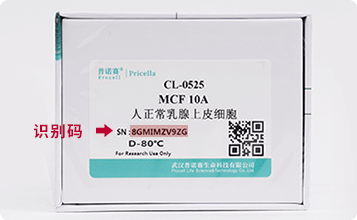货号: CL-0100
Price: ¥1400 ¥1400
生长培养基: MEM(含NEAA)[PM150410]+10% FBS[164210]+1% P/S[PB180120]
产品信息
| 产品名称 | HEC-1-B(人子宫内膜腺癌细胞) |
| 别称 | Hec-1-B; HEC-1B; HEC1-B; HEC1B; Hec1B |
| 生长特性 | 贴壁细胞 |
| 细胞形态 | 上皮细胞样 |
| 冻存条件 |
冻存液:55% 基础培养基+40% FBS+5% DMSO 温度:液氮 |
| 培养方案A(默认) |
生长培养基:MEM(含NEAA)[PM150410]+10% FBS[164210]+1% P/S[PB180120] 培养条件: 气相:空气,95%;CO₂,5%, 温度:37℃ |
| 培养方案B(可选) |
生长培养基: 培养条件: 气相:, 温度:37℃ |
| 推荐传代比例 | 1:2-1:4 |
| 推荐换液频率 | 2-3次/周 |
参考资料(来源文献)
| 背景描述 | HEC-1-B细胞是由H·Kuramoto于1968年分离的HEC-1-A细胞亚株。不同于HEC-A-1的是:HEC-1-B细胞在培养第135天到190天之间表现出稳定的生长周期,且重现扁平,与亲本细胞系相比更具铺路石样。此外,HEC-1-B细胞的主要染色体组是亲本细胞的两倍。 |
| 年龄(性别) | 71Y Female |
| 组织来源 | 子宫内膜腺癌 |
| 细胞类型 | 肿瘤细胞 |
| 肿瘤类型 | 子宫内膜腺癌 |
| 生物安全等级 | BSL-1 |
| 致瘤性 | Yes, in nude mice (The cells form moderately well differentiated adenocarcinomas consistent with endometrial carcinoma (grade II)). Yes, in the cheek pouch of cortisone treated hamsters (The cells form typical papillary adenomas). |
STR位点信息
STR鉴定图
-
Identification and validation of the important role of KIF11 in the development and progression of endometrial cancer(2025)
作者:Wang Biying, Bao Lunmin, Li Xiaoduo, Sun Guang, Yang Wu, Xie Nanzi, Lei Ling, Chen Wei, Zhang Hailong, Chen Man, Zhao Xing, Wan Xiufang, Yuan Rui, Jiang Hongmei
期刊:Journal of Translational Medicine
DOI:10.1186/s12967-025-06081-6
影响因子:6.1
引用产品: HEC-1-B 细胞, Ishikawa 细胞
-
NCAPG promotes the malignant progression of endometrioid cancer through LEF1/SEMA7A/PI3K-AKT(2025)
作者:Zhen Ren, Xiaohan Li, Chun Fu
期刊:Journal of Cancer
影响因子:3.3
引用产品: HEC-1-A 细胞, HEC-1-B 细胞, Ishikawa 细胞
-
Study on the Active Components and Inhibiting Effect of Melastoma dodecandrum Lour. on Human Cervical Cancer Cells Based on Spectrum–Effect Relationship Analysis(2024)
作者:Song Qian, Zuhua Wang, Xiuping Ma, Huiyi Ming, Jing Liu, Jing Yang, Teng Chen, Linli Liu, Jibian Ban, Jiangtao Guo
期刊:Natural Product Communications
影响因子:1.5
引用产品: Hela 细胞, S-180 细胞, HEC-1-B 细胞, SK-OV-3 细胞
-
O‑GlcNAcylation mediates endometrial cancer progression by regulating the Hippo‑YAP pathway(2023)
作者:Lianghao Zhai, Xiaoshan Yang, Jian Dong, Luomeng Qian, Yunge Gao, Yanhong Lv, Ligang Chen, Biliang Chen, Fuxing Zhou
期刊:INTERNATIONAL JOURNAL OF ONCOLOGY
影响因子:5.2
引用产品: AN3 CA 细胞, HEC-1-B 细胞
-
Inhibition of ATM with KU-55933 Sensitizes Endometrial Cancer Cell Lines to Olaparib(2023)
作者:Anqing Zhang, Liqin Zhang, Xia Xie, Dan Liu
期刊:OncoTargets and Therapy
影响因子:4.0
引用产品: Ishikawa 细胞, HEC-1-B 细胞, AN3 CA 细胞, KLE 细胞, RL95-2 细胞
-
Reduced FANCE Confers Genomic Instability and Malignant Behavior by Regulating Cell Cycle Progression in Endometrial Cancer(2023)
作者:Chunying Zheng, Zhen Ren, Hongliang Chen, Xiaorui Yuan, Suye Suye, Huan Yin, Chun Fu
期刊:Journal of Cancer
影响因子:3.9
引用产品: HEC-1-A 细胞, HEC-1-B 细胞
-
IGFBP?rP1 affects the proliferation, apoptosis and macrophage polarization of endometrial cancer cells by regulating the PI3K/AKT pathway(2023)
作者:Juan Gao, Shiqi Suo, Jingxia Li, Chunxia Wang, Ranran Deng, Yuxia Hu, Chunzheng Zhang
期刊:Experimental and Therapeutic Medicine
影响因子:2.7
引用产品: Ishikawa 细胞, HEC-1-A 细胞, RL95-2 细胞, HEC-1-B 细胞, AN3 CA 细胞, THP-1 细胞
-
LINC01857 Exacerbates the Malignant Behaviors of Endometrial Carcinoma Cells by Sponging miR-19b-3p and Recruiting ELAVL1 to Upregulate MYCN(2023)
作者:Cao Rong, Zhao Jiao, Zhang Jingru
期刊:GYNECOLOGIC AND OBSTETRIC INVESTIGATION
影响因子:2.1
引用产品: HEC-1-A 细胞, HEC-1-B 细胞, Ishikawa 细胞, RL95-2 细胞
-
Circ_0075960 targets the miR-202-5p/CTNND1 axis to promote the growth and migration of endometrial carcinoma cells via regulating Wnt/β-catenin signaling activity(2022)
作者:Yan Nian, Xiaorong Li, Jingwen Ma, Ting Gao, Dan Liu
期刊:Journal of Gynecologic Oncology
影响因子:4.8
引用产品: HEC-1-B 细胞, 特级胎牛血清, 人子宫内膜基质细胞, DMEM高糖 培养基, Ishikawa 细胞, RL95-2 细胞
-
FANCD2 promotes the malignant behavior of endometrial cancer cells and its prognostic value(2022)
作者:Chunying Zheng, Zhen Ren, Hongliang Chen, Xiaorui Yuan, Suye Suye, Huan Yin, Zhixian Zhou, Chun Fu
期刊:EXPERIMENTAL CELL RESEARCH
DOI:10.1016/j.yexcr.2022.113388
影响因子:4.2
引用产品: HEC-1-B 细胞, Ishikawa 细胞
-
Q1:为什么我看的文献里的细胞培养条件和你们官网的培养条件不一样呢?
部分细胞是会出现多种培养条件的,我们公司优先选择引种来源的培养条件以及建系者所用培养条件,出现差异的原因是不同实验室在保藏过程中更改了细胞的培养条件,为了避免细胞突然更换培养条件后不适应,建议您优先使用厂家推荐的培养条件培养。

识别码示意图





